Can There Be a "New Color" like Olo?
You wouldn't think that super-intense teal could be mind-blowing, but here we are – and it's just a taste of how strange color and light can be.
A Brief Introduction
Our general experience with light in the real world makes it seem quite simple and straightforward: Light lets us see what color things are. Mixing colors together creates other colors. A rainbow shows us all of the colors by splitting up sunlight. Lenses focus light to take pictures or project images. That kind of stuff that you probably got in basic science and art classes.
For a bunch of years I worked in the "photonics" industry – basically, technologies having to do with light. That field turns out to be quite esoteric, even though the output includes lots of everyday things like TVs, projectors, cameras, and lasers. The deeper I got, the more I learned that light – this seemingly pretty straightforward thing, is far more than it seems, and is often frankly just weird.
As I read more about the science behind the weirdness over the years, I realized more and more that even our own seemingly simple human experience of light and color hides an absolutely mind-boggling amount of physics and human biology. And the more I assembled bits of understanding into a bigger picture of light and color, the more breathtaking it became, flowing between aspects of physics and biology, art and expression. It felt a little like, in the words of Rust Cohle, mainlining the secret truth of the universe.
I always wanted to help other people see the hidden truth of color and light without having to pile through the esoterica of the science, but finding a good starting point was always elusive. Then I noticed a news item that struck just the right chord...
A New Color?
Science news headline writers recently had an unusually easy job making this story sound interesting:
Scientists Unveil 'Olo', a Brand-New Color Humans Have Never Seen Before
This Impossible New Color Is So Rare That Only Five People Have Seen It
And my favorite, from The Atlantic...
The 'Profound' Experience of Seeing a New Color - The Ecstacy of 'Olo'
A new color? Why have only a few people seen it? Ecstacy?
The obvious thing you'll go looking for in the articles is the description of what Olo looks like (as seen by one of the lucky five who've seen it):
He described the color as a beautiful, ultra-intense teal.
(Link to the research paper where you’ll find the quote, if you’re so inclined.)
Now… intense teal sounds a lot like an existing color, not a new one. I can imagine many readers closing the article muttering about yet another sensationalized science headline.
There is, however, actually something quite amazing about olo. And not only is it interesting in its own right, it gets right to the heart of the surprising nature of color itself. That's because before you can say whether it's right to call olo a "new color" or not, you first have to define what you mean by "a color". And once you've done that, you can start to see how something like olo really could be a thing of ecstasy.
Prismatic Color
A reasonable place to start defining "color" is using nature's perfect palette: a rainbow. Thanks to popular science educator, Pink Floyd, we know that we can use a prism to create a rainbow by splitting up white light into the colors it's made of:
What is being "split up" here are different wavelengths of light. For example, if you want to identify a particular shade of green in the rainbow, you can measure it to find out that its wavelength is, say, 540 nanometers.
Understanding what "wavelength" really means is a story for another day. For now, don’t worry about what “nanometers” is about; it's safe to just think of wavelength as a label for different colors from the rainbow. (Color scientists are so used to this way of referring to colors that if you say 680nm or 480nm, they immediately see in their minds eye deep red or pale blue.)
So you might think that we already have a nice simple definition of color:
A color is a particular wavelength of light.
However, it turns out that that definition isn’t very complete. In fact, it has a couple of pretty surprising problems. To explain, we have to open up the eyeball (and the brain, a little bit) and understand exactly what happens when we experience color as humans.
Connecting Color to Our Brains
The retinas in our eyes are made of special light sensor cells (or "photoreceptors" if you want to be fancy). Those cells are spread out across the back of the eye kind of like the pixels of a camera sensor. You probably already know this part. What exactly do those cells do though?
Each sensor sends a signal to the brain if you hit it with light – the more light, the stronger the signal. You can think of the signal from each sensor cell as a reading on a brightness meter, ranging from "I see no light" up to "this is the brightest light I can deal with".
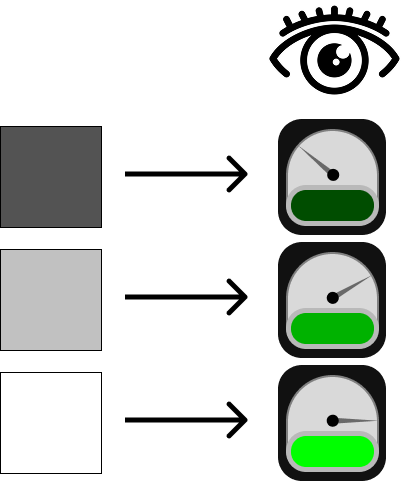
So imagine every sensor cell in your eye wired up to your brain, spitting out a meter reading for each "pixel" in the camera of your eye. But notice in the diagram above that each meter reading doesn't say anything about the color of light hitting it – just the brightness of the light. So it seems like the camera of our eye would only see in black & white.
The way our eyes add color to the picture is by having different kinds of sensor cells, which lets the brain pull a clever trick...
A Clockwork Orange
Let's break down how we experience one color from the rainbow, orange (wavelength of 600nm).
If we only had one kind of sensor cell, there would no be no way to tell this orange from any other color. But fortunately us humans actually have three distinct types of sensor cell, which color scientists tend to call S, M, and L. Each type of sensor cell can only sense brightness from a particular part of the rainbow:
S (for "short", smaller wavelengths) senses brightness of violet/blue colors.
M (for "medium", wavelengths in the middle) senses brightness of colors around the greenish.
L (for "long", larger wavelengths) senses brightness of colors that are around yellow/orange.
Here's the part of the rainbow the S, M, and L sensors can each see respectively.
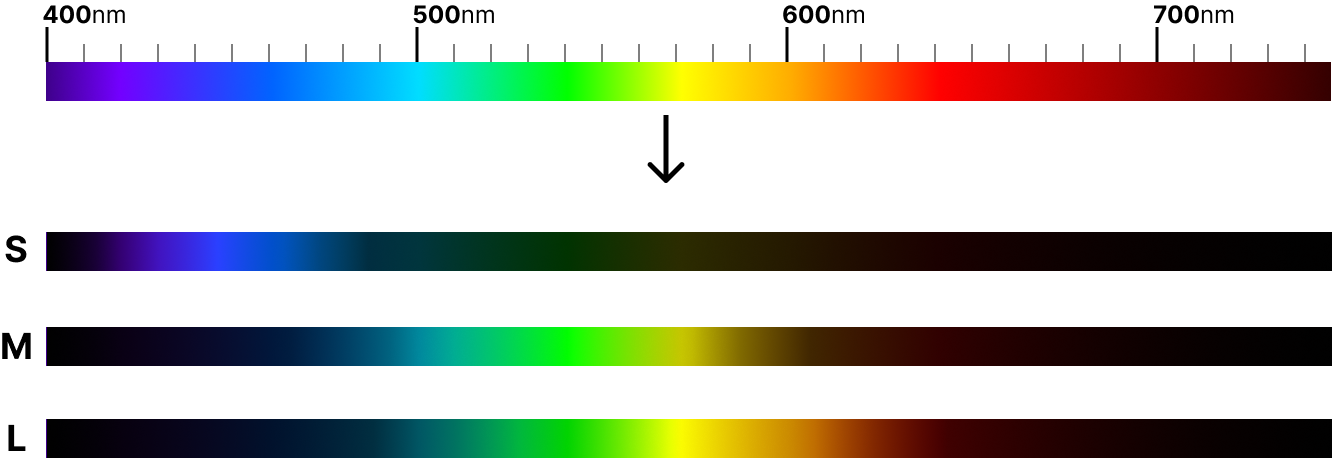
Remember, though, that each sensor doesn't know what colors are hitting it. So what the three types see is really more like this.
If each type of sensor is hooked up to a brightness meter, what do those meters show for our 600nm orange light?
The S sensors (which only see violet/blue) see almost nothing of our orange, the M sensors (which see around greenish) see a little brightness, and the L sensors (seeing colors around yellow/orange) see quite a lot of brightness. Like this:

Now here's the really important and interesting part:
The brain combines the readings from all three meters to decide what color you see.
Let's stop for a moment to understand this, because it's quite amazing.
When we look at a rainbow, we see an array of vibrant colors that couldn't look more distinct. Try to count the colors and you'll pick out maybe 7 "major" distinct colors, with smooth shading between them.
Given that, you might expect that our eyes would need at least 7 different kinds of sensor cells to create that experience. And yet, because of some clever clockwork in our brain, we can make do with just three!
How does that work? When the three types of sensors send out their meter signals, the brain is looking at the ratios between them to figure out the color. Like this:
What is red, to the brain? It's the kind of light that mostly lights up the L sensors, just a little bit of M, and no S at all.
Moving down from there, orange is when there is a greater ratio of M – and yellow is when there is even more M. Green is when M now reads higher than L (still with no S). Cyan has less L still and brings in a little S. Blue loses nearly all L and most of the M, and violet is just about only S signal.
The ratio of those three meter readings is enough for the brain to create the mental experience of a rainbow in all its vibrancy, letting us see the different wavelengths distinctly.
So when we look at our 600nm orange, a special mix of L and M sensor signals are sent to the brain. The brain then creates a mental symbol – a new experience – for that combination of signals that we come to think of as a particular shade of orange. It’s the mental symbol that is triggered for our experience when looking at a sunset or an orange fruit, and maybe we start to associate it with feeling of a cool dusk breeze or the taste of citrus. (And there’s more for another day about that translation of sensation into the realm of mental symbols…)
Getting Back to "What is Color"
This is all interesting, but why is there a problem with our proposed definition of color?
Here, again, is what we proposed:
A color is a particular wavelength of light.
Now that we understand more what’s going on in the eye and brain, this has two problems.
First, let's look what happens if you show more than one wavelength of light to the eye at the same time. Let's combine a some red (640nm) with some green (540nm).
The sensors in the eye measure a combination of the light from those colors. Basically, it's like taking the meter readings we'd get for red and for green separately and averaging them together into a single set of S, M, and L readings.
And once we've combined those readings, the result is familiar if we look at the meter readings above for single colors...
Mixing red and green creates the same meter readings that we got for yellow from the rainbow. That means your brain can't tell the difference between rainbow-yellow (570nm) and red + green (640nm + 540nm). The colors (by their wavelengths) are very different, but the resulting meter readings are the same, and so the experience the brain creates either way... is yellow.
This is kind of mind bending, but we see it every day.
Computer and phone screens can't create just any wavelength of light they want – they are usually designed to only create red, green, and blue light. But using different combinations of red, green and blue, it turns out that you can use the trick above to fool the sensors in your eye to see (almost) any color in the rainbow.
A side note here: You may have thought that the sensor types in our eyes were red, green, and blue – matching up with the red green and blue of computer screens and camera sensors. As we saw above looking at the S/M/L sensors, that's not actually true. However, using some clever math, we can show that as long as you have a wide enough range of any three colors, you can reproduce just about any color the eye's three sensors can see. Red, green, and blue provide a usefully wide "color gamut" to capture or display colors intended for humans.
It isn't just a trick of computer screens either. Colors in nature are almost always mixtures of lots of wavelengths. What looks like a yellow flower might actually be reflecting almost no yellow light around 570nm. It might just be reflecting lots of both red and green and your brain sees that as yellow. That yellow is no less "real" than the one on the rainbow, because your experience of yellow is defined by your brain.
Another side note: If we had a fourth sensor cell type in our eyes – maybe one far at the reddish end – we would in fact be able to tell the difference between yellow-from-the-rainbow and yellow-from-red-and-green. They would look like different colors entirely. What would those colors look like? Nobody knows; our brains aren't wired for it. But the brain of the mantis shrimp is, because it has a dozen or more types of sensor cells in its eyes. A mantis shrimp would be thoroughly unconvinced looking at a picture on a computer monitor, trying to recreate colors with only red, green, and blue!
So a color is not just "a particular wavelength of light", as we originally proposed. Problem #1, as we've just seen, is that what we experience as a single color (like yellow) isn't only created by a single wavelength. It can also be created by a combination of wavelengths.
Problem #2 is where it gets really interesting: There are very real colors we experience that have no single wavelength at all. They don't exist in the rainbow.
How's that possible?
Look again at the meter readings of the rainbow colors above. Even pretty small differences in ratios can create the experience of very different colors in the brain. But looking at the different ratios of meter readings for the rainbow colors, we can imagine some pretty distinct ratios of meter readings that don't appear at all.
For example, none of the rainbow colors combine meter readings lots of S and L at the same time.
Is that combination of meter readings even possible? It's actually pretty easy to get close to, but we need to use a mixture of colors: Blue light drives pretty much only the S sensors and red light drives pretty much only the L sensors. So if we combine blue and red light, we can get quite close to our mystery not-in-the-rainbow ratio.
What happens when you feed the brain signals like this?
The answer is, basically, barbie pink. Pretty attention-grabbing, right? It’s not so surprising when you realize that it’s a color pushing your brain’s buttons in a pretty distinct way.
You won't find that hot pink/fuchsia color in the rainbow, because it can only be made by a combination of wavelengths at opposite edges of the rainbow’s spectrum. Whether you’re seeing that color on Barbie, the fuchsia square on your computer monitor above, or a flower in nature, the only way to get the S and L sensors to light up to create that color is with a combination of blueish light and reddish light at the same time.
So defining “color” is a lot more complicated than it first seems. We've shown that the experience of a color isn't just a single wavelength – it can be created by a combination of wavelengths. We've also shown that there are very real (and very attention-grabbing) colors that can't be created by a single wavelength at all.
What About Olo?
Right, so what kind of color is olo, from the science headlines?
Look again at the meter readings for the rainbow colors. We found a ratio that wasn't present there – lots of S and L with no M – that creates a quite shocking color: Barbie pink.
There's another distinct ratio missing: what if we could have only M, with no S or L?
Since unique ratios always create the experience of different colors in the brain, we would expect that this would create quite a different color experience.
That color is what the researchers named olo. But it's much more elusive than Barbie pink.
I’m completely unable to put an example square of olo on this page like I can with Barbie pink. Fuchsia is a combination of two signals, which we could do pretty well using red and blue to isolate the S and L sensors. But to create olo, we need to isolate just one signal: M. Because M is in the middle of the rainbow, there is no combination of colors that can do that. All of the wavelengths that push the M meter up also push up either S or L. For example, you can see green and cyan push up the M sensor readings strongly, but green also pushes up L quite a lot, and cyan even includes a little bit of S.
To trigger M sensors alone, you'd somehow have to put light only on M cells while preventing it from falling on S or L cells. That's impossible when looking at anything in the world because sensor cells are extremely small and any spot on the retina includes all three types of sensor. So instead you'd have to do something crazy like:
Scan a specific person's eyeball and create a map of all of their individual sensor cells by type
Create a super-fine laser that you can aim into an eyeball and aim precisely enough to hit exactly one sensor cell at a time
Track your subject's eye and fire the laser at a cluster of individual M sensor cells, avoiding all of the S and L cells
If you could do that, then you would have full control to create whatever ratio of meter readings you want, including the mysterious M-only olo ratio.
And that is literally what the olo researchers did, which is absurd. It's also why only 5 people have seen it – it's extremely difficult to do the individual eyeball scans.
So...
We know what L alone looks like: Red.
We know what S alone looks like: Violet.
What does M alone look like, unmuddied by other signals? Olo.
Olo is kind of close to green or cyan – which also have a lot of M – but we'd expect it to be a color that is far more intense. It might be kind of like the crazy intensity of Barbie pink, but "opposite" in some sense (since it is made from the opposite sensor ratio).
And indeed here is what the lucky 5 had to say about the saturation (the intensity/vibrancy) of olo:
Subjects consistently rate olo’s saturation as 4 of 4, compared to an average rating of 2.9 for the near-monochromatic colors of matching hue
It has to be incredible to see a color that is so much more intense and vibrant than the nearest "regular" color at its brightest.
The best I can imagine is by comparing it to the opposite. Take the most intense cyan your computer monitor can produce, and then start adding other colors to desaturate it (less saturation). It fades... becoming turquoise, pale aquamarine, a misty sky blue, and then ultimately white – the color we see when all three types of color sensors are activated at the same time (although there's much more to white - another story for another day).
Olo is in the other direction, becoming more saturated than cyan/teal by removing colors that would normally be impossible to remove. It would go from an already quite intense color to something... unimaginable unless you’ve seen it.
Olo is a real color that our brain can experience, but not by looking at any light or object in the world that can ever be created (which makes it very irritating that somebody is claiming to now sell olo paint – it's just teal, dude). Olo can only be created by reaching into the eye and plugging straight into our individual sensor cells.
Crazy. I hope I can see it someday.
Thinking Bigger
Olo is just an introduction - a beautiful one to the true nature of color and light and how full of wonders it can be. So let me get a little Sagan here and point the way to the bigger picture...
Olo has given us a taste of a richer answer to our original question of what a color is, but not a very conclusive one. The wavelengths-of-the-rainbow definition seems to be contradicted by the ratios-of-color-sensors definition. So which is it?
It's both... and many more, in fact.
The prismatic spectrum of wavelengths in the rainbow are colors in a very important way; they are fundamentals of physics, unchangeable and precisely measurable. Those colors have deep meaning.
All matter in the universe is constantly vibrating at an atomic level, and those vibrations create light that broadcasts the echoes of those unique vibrations as different wavelengths of color. The whole Universe rings with complex chords of color, keyed to the tune of each object's individual chemistry as things glow, collide, explode, and live. As light spreads outward, it falls on other objects and strikes new chords in those materials that are rebroadcast once again as combinations of color.
The vibrant colors of crystal formations, the green of leaves, the red of blood, the blue of the atmosphere glowing in sunlight, and the swirling chemical hues of planets, stars, and galaxies – their colors all sing of their essence, far beyond what we can see with our eyes.
At the same time, color is also truly subjective. It is a creation of the mechanisms of our human eyes and mind. By capturing light, the sensor cells in our eyes hum in sympathy with the vibrations of objects right in front of us and at unthinkable distances. As we've seen, our eyes can only hum three closely-spaced notes to the brain, so there are many colors we cannot see directly. But even that is enough to create an incredible awareness of the world around us, a beautiful glimpse of the rich symphony of Earth and the Universe.
Humans have also learned how to extend our senses, building artificial "eyes" that can see exquisitely fine gradations of color, and wavelengths billions of times beyond violet or red. And how strange light can become in these exotic colors! In some wavelengths, a glass window is opaque while a slab of metal is completely transparent. In others, a seemingly dark patch of sky is bright with galactic activity.
Increasingly we can listen in on the full symphony of color around us, giving us profound insights into the Universe and the fabric of reality, because light itself is woven deeply into the finest structure of that fabric.
You've probably picked up that the story of Olo leads off in a number of other directions – stories for another day. And I hope to pick up those threads and see where they lead in future articles...







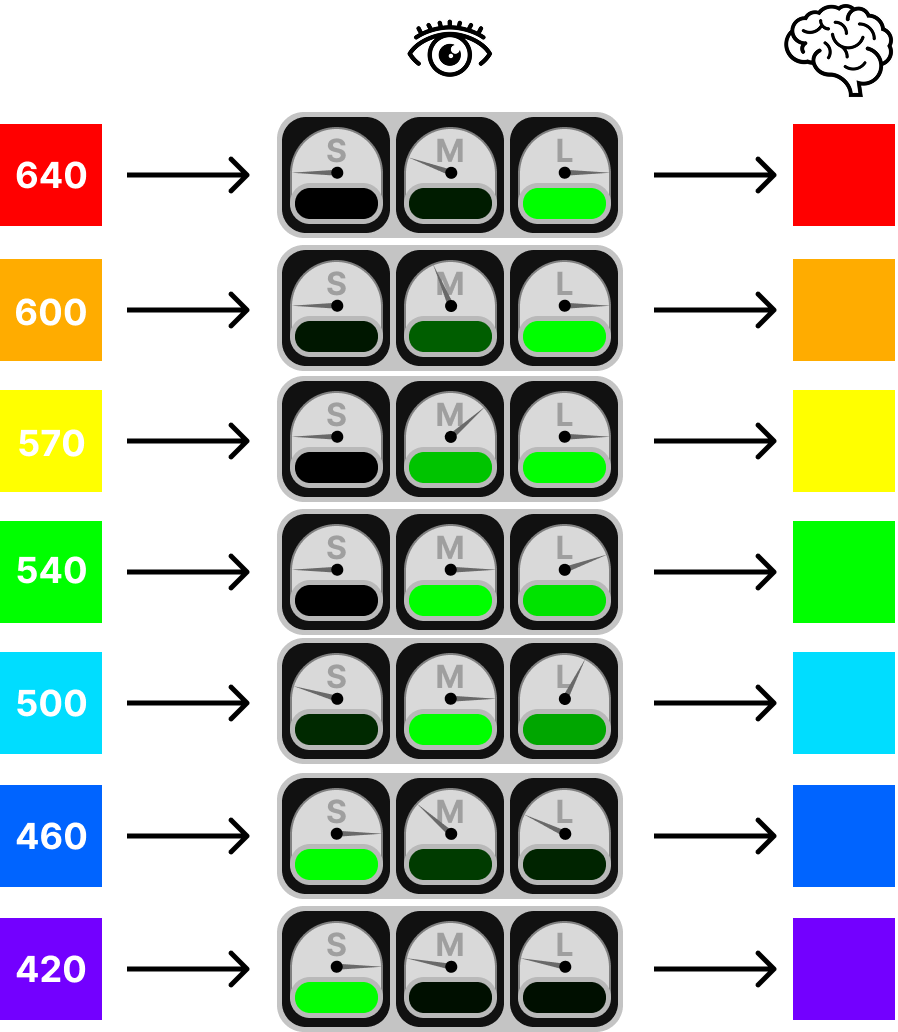
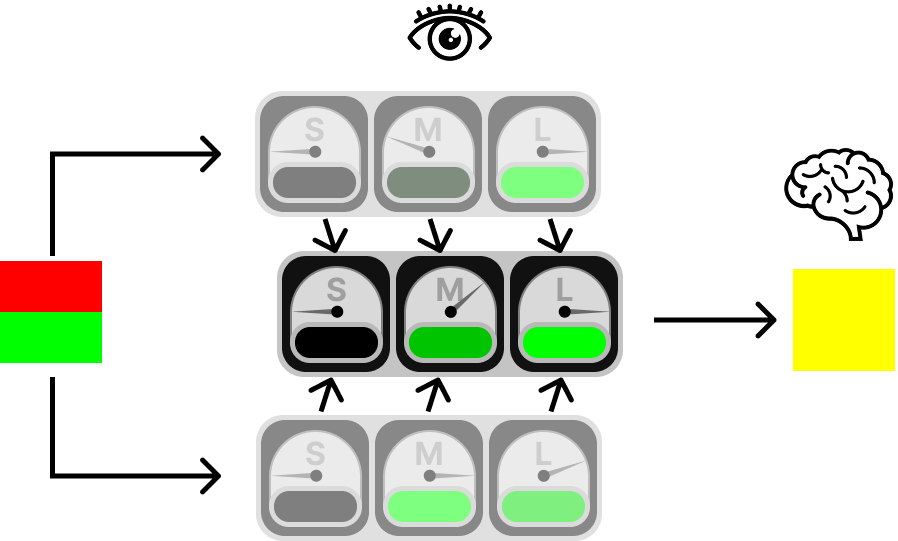

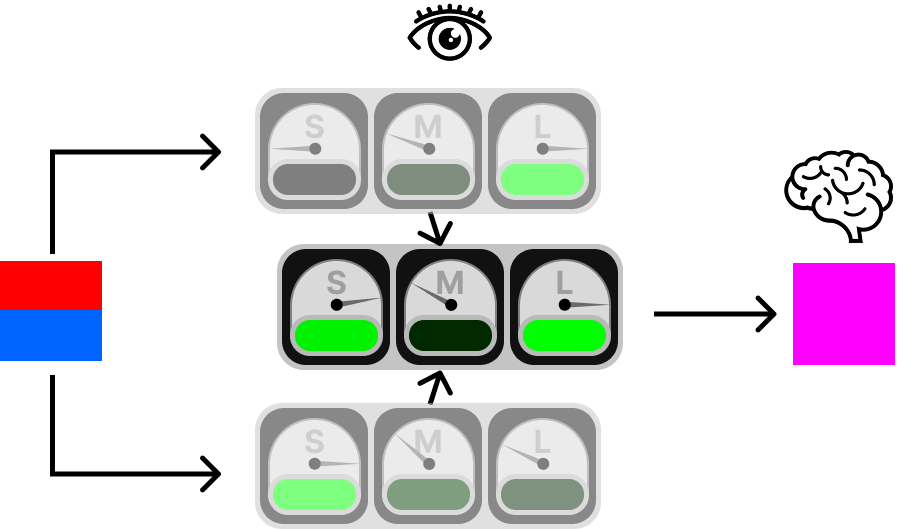



Very interesting! I had no idea that there existed a perceivable color not known to most people!
A great explanation!
Reminds me of an article I read a few years ago (which had graphs for the sensitivity of RGB across wavelengths), sadly I can't remember where - but I like your presentation even more, I think it's more accessible, and I love your graphics - the RGB gauges and the saturated colour bands instead of graphs for the RG sensitivity.
Thanks Matt!